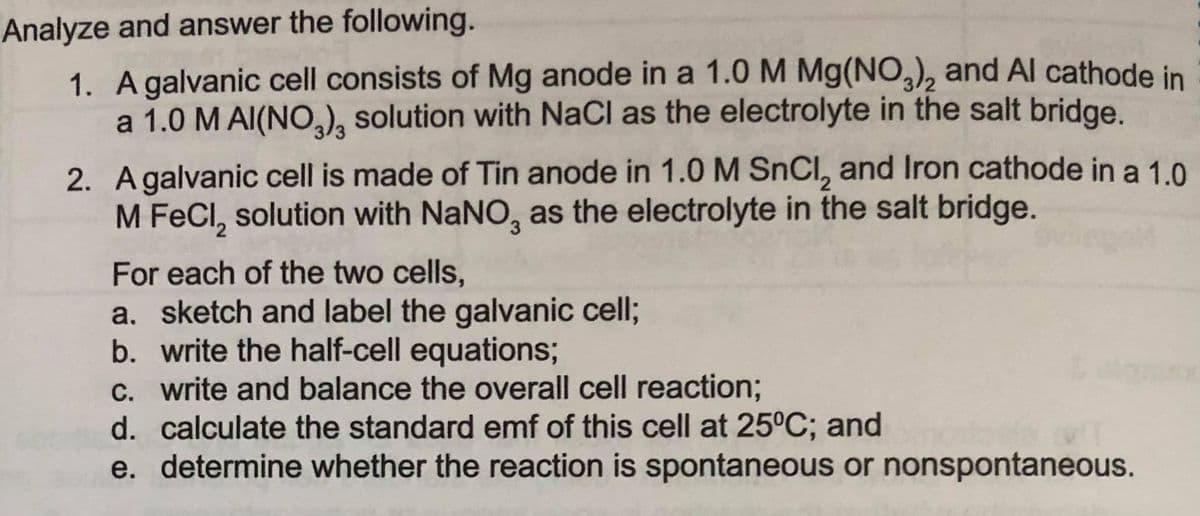1. A galvanic cell consists of Mg anode in a 1.0 M Mg(NO,), and Al cathode in a 1.0 M AI(NO,), solution with NaCl as the electrolyte in the salt bridge. 2. A galvanic cell is made of Tin anode in 1.0M SnCl, and Iron cathode in a 1. M FeCl, solution with NaNO, as the electrolyte in the salt bridge. For each of the two cells, a. sketch and label the galvanic cell; b. write the half-cell equations; c. write and balance the overall cell reaction;
1. A galvanic cell consists of Mg anode in a 1.0 M Mg(NO,), and Al cathode in a 1.0 M AI(NO,), solution with NaCl as the electrolyte in the salt bridge. 2. A galvanic cell is made of Tin anode in 1.0M SnCl, and Iron cathode in a 1. M FeCl, solution with NaNO, as the electrolyte in the salt bridge. For each of the two cells, a. sketch and label the galvanic cell; b. write the half-cell equations; c. write and balance the overall cell reaction;
Chapter18: Introduction To Electrochemistry
Section: Chapter Questions
Problem 18.3QAP
Related questions
Question

Transcribed Image Text:Analyze and answer the following.
1. A galvanic cell consists of Mg anode in a 1.0 M Mg(NO,), and Al cathode in
a 1.0 M AI(NO,, solution with NaCl as the electrolyte in the salt bridge.
2. Agalvanic cell is made of Tin anode in 1.0 M SnCl, and Iron cathode in a 1.0
M FeCl, solution with NaNO, as the electrolyte in the salt bridge.
For each of the two cells,
a. sketch and label the galvanic cell;
b. write the half-cell equations;
c. write and balance the overall cell reaction;
d. calculate the standard emf of this cell at 25°C; and
e. determine whether the reaction is spontaneous or nonspontaneous.
Expert Solution
This question has been solved!
Explore an expertly crafted, step-by-step solution for a thorough understanding of key concepts.
Step by step
Solved in 4 steps with 4 images

Knowledge Booster
Learn more about
Need a deep-dive on the concept behind this application? Look no further. Learn more about this topic, chemistry and related others by exploring similar questions and additional content below.Recommended textbooks for you


Principles of Modern Chemistry
Chemistry
ISBN:
9781305079113
Author:
David W. Oxtoby, H. Pat Gillis, Laurie J. Butler
Publisher:
Cengage Learning

Chemistry by OpenStax (2015-05-04)
Chemistry
ISBN:
9781938168390
Author:
Klaus Theopold, Richard H Langley, Paul Flowers, William R. Robinson, Mark Blaser
Publisher:
OpenStax


Principles of Modern Chemistry
Chemistry
ISBN:
9781305079113
Author:
David W. Oxtoby, H. Pat Gillis, Laurie J. Butler
Publisher:
Cengage Learning

Chemistry by OpenStax (2015-05-04)
Chemistry
ISBN:
9781938168390
Author:
Klaus Theopold, Richard H Langley, Paul Flowers, William R. Robinson, Mark Blaser
Publisher:
OpenStax

Chemistry: Principles and Reactions
Chemistry
ISBN:
9781305079373
Author:
William L. Masterton, Cecile N. Hurley
Publisher:
Cengage Learning

Physical Chemistry
Chemistry
ISBN:
9781133958437
Author:
Ball, David W. (david Warren), BAER, Tomas
Publisher:
Wadsworth Cengage Learning,

Chemistry
Chemistry
ISBN:
9781305957404
Author:
Steven S. Zumdahl, Susan A. Zumdahl, Donald J. DeCoste
Publisher:
Cengage Learning